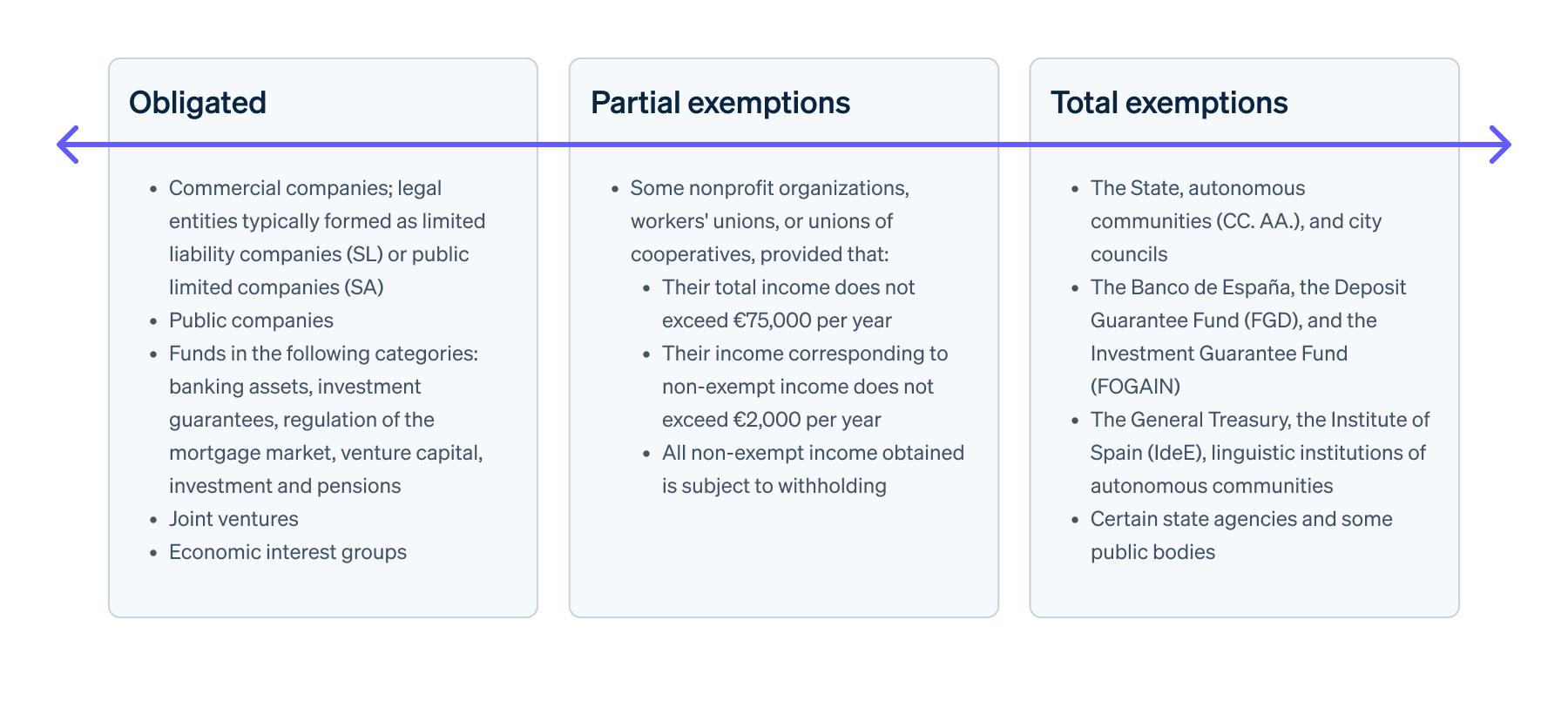スペインで事業を行うすべての企業は、直接税だけでなく、商品やサービスに対する 付加価値税(VAT) や 間接税 などの税務義務を常に最新の状態に保つ必要があります。直接税は通常、事業利益に基づいており、企業がこれらの金額をスペイン税務庁 (AEAT) に直接支払うことから、そのように呼ばれています。
最も一般的な 2 つの直接税は、個人向けの個人所得税 (IRPF、または「impuesto sobre la renta de las personas físicas」) と企業向けの 法人所得税(IS、または「el impuesto de sociedades」) です。
ほとんどの企業は、フォーム202 を使用して法人所得税を 分割払い で決済することを選択するか、または支払う必要がありますが、他の企業は一括で支払います。どちらの場合も、フォーム200 を使用して年次法人所得税申告書を提出する必要があります。
この記事の内容
- フォーム 200 とは何なのか、何のために必要なのか?
- フォーム 200 を提出する必要があるのは誰か?
- フォーム 200 の提出が免除されるのは誰か?
- フォーム 200 の提出期限はいつか?
- フォーム 200 は延期できるか?
- フォーム200 の提出方法
フォーム 200 とは何なのか、何のために必要なのか?
フォーム 200 (スペインでは「Modelo 200」として知られています) は、企業が AEAT に対して年次経済報告を行い、利益に対する法人所得税を支払うために提出する納税申告書です。これを解決するには、最終的な支払い額を決定するために、収益、費用、および控除を詳細に説明する必要があります。
企業はフォーム 200 を使用して、分割払いまたは一括払いで法人所得税の納税義務を支払います。前者の場合、会社は AEAT に四半期ごとに支払いを行っているため、このフォームを提出した後に支払うべき金額ははるかに低くなります。
さらに、VAT還付 と同様に、過払いの場合は法人税が還付される場合がある ため、AEAT が差額を払い戻すことに注意してください。
フォーム 200 を提出する必要があるのは誰か?
概要を明確にするために、次の表は、フォーム 200 の提出を義務付けられている企業と、部分的または全体的に免除されている事業体の概要を示しています。

フォーム 200 の申請は、法人所得税の対象となる課税対象企業 と見なされるスペインに拠点を置く企業および納税者に義務付けられています。完全なリストは次のとおりです。
- 営利会社 とは、通常、有限責任会社 (SL、または「sociedades limitadas」) または公開有限責任会社 (SA、または「sociedades anónimas」) として設立された法人を意味します。
- 公開企業 (州、自治コミュニティ、州、地方のいずれに依存しているかは問わない)
- 次のカテゴリの資金:銀行資産、 投資保証、住宅ローン市場の規制、 ベンチャーキャピタル、 投資ファンド、および 年金
- 合弁事業
- 経済的利益団体
フォーム 200 の提出が免除されるのは誰か?
ほとんどの法人と納税者はフォーム 200 を提出する必要がありますが、いくつかの 全額および一部免除 があります。
全額免除
全額免除とは、支払うべき法人所得税がないため、企業がフォーム 200 提出を免除されることを意味します。これは、次の団体に適用されます。
- 州、自治コミュニティ (CC.AA.)、および市議会、およびその自治団体。
- スペイン銀行、預金保証基金(FGD)、投資保証基金(FOGAIN)。
- 一般財務省および社会保障を管理するその他の団体。
- スペイン学士院 (IdeE) とその公式の王立アカデミー。同様に、王立スペインアカデミー (RAE) と同様の公用語と目的を持つ自治コミュニティの言語機関。
- スペインのラジオテレビ公社 (RTVE) およびスペインデータ保護庁 (AEPD) を含む特定の国家機関、一部の公的機関、および 1997 年 6 月の法律第 9 条および第 10 条の追加規定に記載されている団体。
一部免除
一部の非営利団体、労働組合、協同組合の組合など、法人所得税が 一部免除 されている団体は、次の条件を満たす場合、フォーム 200 を提出する必要はありません。
- 総収入が年間 7 万 5,000 ユーロを超えないこと
- 非課税所得に該当する利益が年間 2,000 ユーロを超えないこと
- 得られたすべての課税対象所得は源泉徴収の対象となること
フォーム 200 の提出期限はいつか?
全額または一部の免除が対象にならない場合は、課税期間の終了日によって異なる指定された期限内にフォーム 200 を提出する必要があります。ほとんどの場合、申告期間は暦年と一致しますが、常にそうであるとは限りません。納税期間によって期限がどのように異なるかを次に示します。
- 暦年と一致する場合、フォーム 200 の提出期限は 7 月 1 日から 7 月 25 日までです。
- 暦年と異なる場合でも、期限は課税期間の終了から 6 カ月後から 25 暦日です。たとえば、会社が 2024 年 10 月 31 日に会計年度を終了する場合、2025 年 5 月 1 日から 5 月 25 日の間にフォーム 200 を提出する必要があります。
会社の会計年度には異なる開始日と終了日を選択できますが、暦年に合わせると申告がより簡単になります。いずれにせよ、会計年度は常に 12 カ月間続かなければなりません。
会社が解散する場合、解散手続きが完了してから 6 カ月後にフォーム 202 を提出する必要があります。
フォーム 200 は延期できるか?
2003 年 58 号法に基づき、税金債務の支払いを延期できますが、いくつかの例外があり、法人所得税はこれに該当しません。Agencia Tributaria に対する債務がフォーム 202 に起因しない場合、フォーム 200 を使用してこの税金の年次決算を延期できます。言い換えれば、債務がフォーム 202 の分割払いによるものでなく、フォーム 200 から発生した場合、法人所得税を繰り延べることができます。
フォーム 200 を延期申請と共に提出するのは簡単です。記載の期日までにお支払いいただけない場合は、この AEAT 動画の手順 に従ってください。ただし、フォーム 200 による分割払いはフォーム 202 で処理される分割払いとは異なり、延滞利息 が発生し、2024 年の場合は未払い額の 4.0625% になります。
フォーム 200 の提出方法
AEAT は、フォーム 200 を電子形式で提出するために特別に開発されたオンラインサービスを提供しています。このサービスは非常に簡単であり、デジタル証明書または Cl@veを使用してSociedades Web ポータルにアクセスするだけで使用できます。
ログイン後、ポータルは入力する個々のフィールドをステップバイステップで案内します。納税者番号(NIF)、会社名、CNAE (National Classification of Economic Activities) コード、課税期間中の会社の平均従業員数など、会社に関するすべての情報を入力すると、「適用」ボタンが表示され、これまでに入力したすべてのデータが自動的に保存されます。ボタンをクリックする前に、すべての情報が正しいことを確認してください。
その後、XML ファイルを添付するか、情報を手動で入力することで、会社の会計データをインポートできます。
フォーム 200 は非常に多くのデータを必要とする文書ですが、AEAT によって開発された専用ウェブサイトのおかげで通常は簡単に入力を行えます。追加情報が必要な場合は、AEATの公式チャンネルのビデオの説明をご確認ください。
この記事の内容は、一般的な情報および教育のみを目的としており、法律上または税務上のアドバイスとして解釈されるべきではありません。Stripe は、記事内の情報の正確性、完全性、妥当性、または最新性を保証または請け合うものではありません。特定の状況については、管轄区域で活動する資格のある有能な弁護士または会計士に助言を求める必要があります。